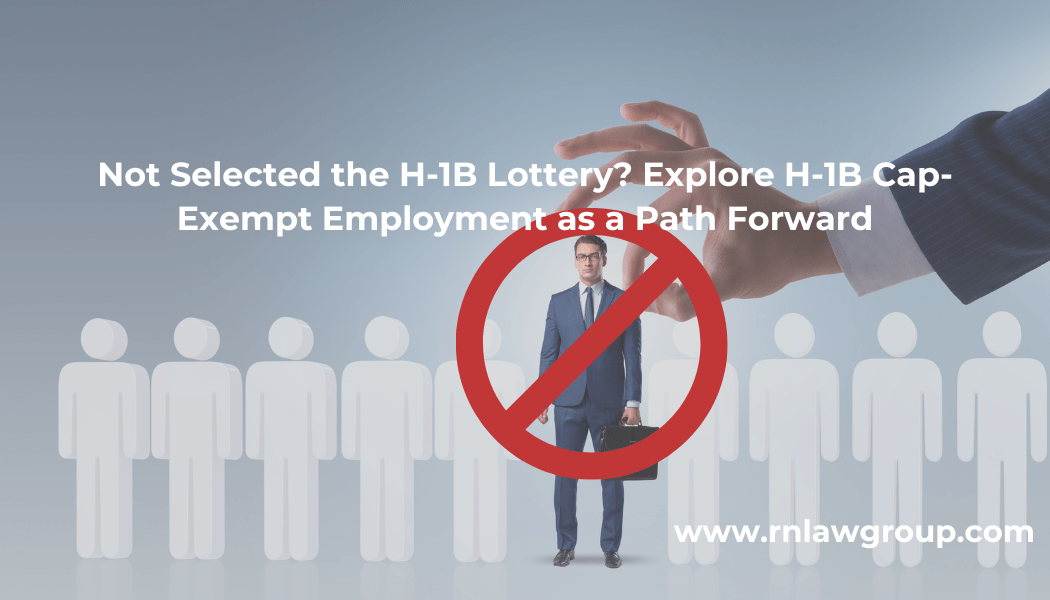
Not Selected the H-1B Lottery? Explore H-1B Cap-Exempt Employment as a Path Forward
The H-1B visa remains one of the most common routes for U.S. employers to hire skilled foreign nationals to work temporarily in the United States. However, each year, many talented individuals find themselves at a crossroads after not being selected in the H-1B lottery due to the annual numerical cap. With 85,000 new H-1B visas available annually (65,000 for the “regular cap” and 20,000 under the advanced degree exemption), demand has consistently exceeded supply.
One alternative option is employment with a cap-exempt employer, a special category of organizations that are not subject to the annual H-1B numerical cap. In this article, we’ll walk you through what H-1B cap-exempt employment means, the types of organizations that qualify, and benefits and key considerations.
What Is an H-1B Cap-Exempt Employer?
H-1B cap-exempt employers are organizations that can sponsor H-1B visas without being subject to the quota. This means that an eligible employer can file an H-1B petition on behalf of a foreign worker at any time during the year, without regard to the annual cap. This gives them significant flexibility and allows employers and foreign nationals to bypass the lottery system altogether.
H-1B cap-exempt employers include:
- Institutions of higher education: An institution of higher education is an educational institution in any State that meets the following conditions:
- Is a public or other nonprofit institution;
- Admits as regular students only those having a certificate of graduation from a school providing secondary education, or the recognized equivalent of such a certificate;
- Is legally authorized within such State to provide a program of education beyond secondary education;
- Provides an educational program for which the institution awards a bachelor’s degree or provides not less than a 2-year program that is acceptable for full credit toward such a degree; and
- Is accredited by a nationally recognized accrediting agency or association.
- Non-profit entities related or affiliated with institutions of higher education: A nonprofit entity is considered “related to or affiliated with” an institution of higher learning if any of the following conditions are met:
- The two entities have shared ownership or control “by the same board or federation”;
- The nonprofit is operated by the higher education institution;
- The nonprofit is “attached to” a higher education institution as a “member, branch, cooperative, or subsidiary”; or
- The nonprofit has “entered into a formal written affiliation agreement” with the higher education institution that “establishes an active working relationship between” the two entities “for the purposes of research or education, and a fundamental activity of the nonprofit entity is to directly contribute to the research or education mission of the institution of higher education.” (e.g. Veterans Affairs hospital that would be considered affiliated with a medical school based on a contract or agreement for the training or education of health personnel).
- Non-profit research organizations: A nonprofit research organization is an organization that is mainly engaged in basic research and/or applied research.
- Government research organizations: A governmental research organization “is a federal, state, or local entity whose primary mission is the performance or promotion of basic research and/or applied research.” Basic and applied research for such organizations have the same definitions as for nonprofit entities, above.
Additionally, even though an H-1B worker is typically exempt from the cap when directly employed by a qualifying entity, it’s important to understand that direct employment is not always required for the exemption to apply. In some cases, a petitioner that is not one of the four recognized cap-exempt entities can still qualify for the exemption if the employee spends most of their working hours at a qualifying institution and their job duties directly and predominately further the essential purpose, mission, objectives or functions of the qualifying institution, organization or entity, namely, either higher education, nonprofit research or government research. In essence, the petitioner must clearly show that the H-1B worker’s role meaningfully contributes to the goals or operations of the cap-exempt organization.
Benefits and Key Considerations:
Benefits of Cap-Exempt Employment
- No H-1B Lottery Wait: Cap-exempt employers can file H-1B petitions year-round, meaning you don’t have to wait for next year’s lottery or worry about lottery selection odds.
- Hiring Flexibility/Immediate Start: Cap-exempt employers have the ability to recruit foreign professionals for specialized roles without being restricted by the annual H-1B cap. This allows them to access a global talent pool and fill critical positions that may be challenging to staff. Also, once the petition is approved, the foreign national can begin work—no need to wait for the October 1 start date tied to cap-subject H-1Bs.
- Career Growth Opportunities: Employment with a cap-exempt organization, especially in academia or research, can offer distinctive pathways for professional growth and advancement. Employees often gain access to innovative research initiatives, collaborative projects, and valuable resources that support continued education and skill development.
- Concurrent Employment Flexibility: You may be eligible to work concurrently for a cap-subject employer while maintaining your cap-exempt H-1B role. This can be an ideal way to explore industry experience while staying within legal status.
- Cap-Subject Employment Ends: Foreign workers must keep in mind that if the cap-exempt employment ends, they will be subject to the cap unless subsequently employed by another cap-exempt employer or unless they were previously counted against the H-1B cap in the past six years. Also, foreign workers are still subject to the H-1B 6 year limit even if they are working for a cap-exempt employer.
H-1B cap-exempt employers serve a vital function in enabling skilled foreign professionals to work in the United States. By not being limited by the annual H-1B cap, these employers help foster innovation, global collaboration, and academic advancement. For foreign professionals, pursuing employment with cap-exempt institutions can be a strategic route toward achieving career aspirations while making meaningful contributions to knowledge and technology.
With thorough research, proactive networking, and a clear understanding of eligibility requirements, candidates can enhance their prospects of securing a position with a cap-exempt organization. Although the process may demand commitment and persistence, the professional opportunities available through cap-exempt employment can lead to a rewarding and impactful career.
If you are an H-1B employer or foreign worker and have questions about cap-exempt employment, our team at Reddy Neumann Brown PC can help! Schedule a consultation with any of Reddy Neumann Brown PC’s qualified business immigration attorneys at Appointments.
By: Krystal Alanis
Krystal Alanis is a Partner at Reddy Neumann Brown PC and manages the firm’s PERM Labor Certification Department, where she oversees all EB-2 and EB-3 employment-based green card matters. Krystal guides clients from a variety of industries through the maze of the PERM Labor certification process and has handled thousands of PERM applications throughout her career with Reddy Neumann Brown PC. Krystal also guides employers and individuals through the I-140 and Adjustment of Status process, and assists clients with temporary work visa petitions (e.g., H-1B, TN, L-1, E-2). With over 13 years of immigration experience, Krystal is able to advise her clients with confidence and recognize any potential pitfalls that may arise.

